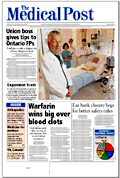|
March 18, 2003 Volume 39 Issue 11
New device suggests blood flow could one
day power pacemakers
New device suggests blood flow could one day power
pacemakers
By Mike Martin
BANGALORE, INDIA – Using nanotubes, scientists here have
invented what they see as the precursor to an arterial
turbine—a device that would use flowing blood to generate
enough electrical charge to power a pacemaker.
The research team, led by Dr. Ajay Sood (PhD), a physicist
at the Indian Institute of Science, refers to the invention as
the world's first "flow sensor." When downsized, it would be
small enough to fit in a blood vessel and make possible a
pacemaker without a cumbersome battery.
"Our experiments have demonstrated for the first time that
flow induces electrical response in single-walled carbon nano-
tubes," Dr. Sood said. "The response of the nanotubes is
relatively large even for very small flow velocities, of the
order of 1 mm per second."
The researchers packed bundles of nanotubes between two
metal electrodes, producing a sensor 1 mm long, 0.2 mm thick
and 2 mm wide.
Introducing water flowing at a speed of 5 mm/s induced a
voltage of 0.65 mV in the device along the flow direction. As
the liquid velocity increased, the voltage went up almost
logarithmically.
Eliminating the surgery required to replace pacemaker
batteries interests Dr. Nieca Goldberg, chief of the Cardiac
Rehabilitation and Prevention Centre at Lenox Hill Hospital in
New York City. "It would reduce the need for surgical
procedures to change the pacemaker battery, which is usually
required at an average time of five years."
The flow sensor could also be used to track blood flow
inside arteries and veins in real time. "Real-time blood flow
monitoring could give some idea how well the heart is
functioning," said Dr. Judy Tharp, a Lansing, Kan.-based
clinician and general practitioner.
A battery-less pacemaker may have many advantages, but
there are concerns. Disadvantages related to the frail
condition of elderly patients might adversely affect the
pacemaker's operation.
Potential "dysrhythmias" could also disturb the blood flow
sensor, Dr. Tharp said. "If a patient suddenly experiences a
rhythm disturbance where blood is not flowing, the
battery-less pacemaker won't work."
Until the unit is fully tested and all concerns laid to
rest, "we need to take a wait-and-see approach until this
technology is developed," Dr. Goldberg added.
Dr. Sood is confident the flow sensor will eventually
become a routine cardiac implant.
"At present, we are in the process of patenting the device
in both India and the United States," said Dr. Sood. Clinical
trials in animals would then follow.
| 